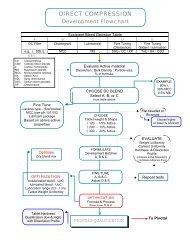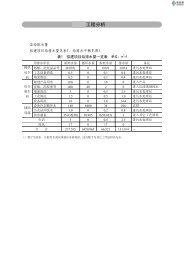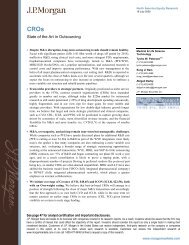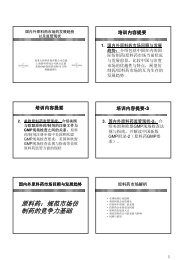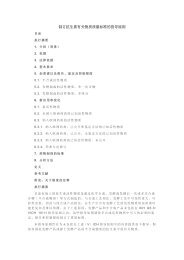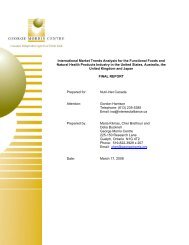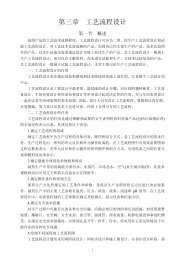Polyethylene Glycol is an addition polymer of ethylene oxide and ...
Polyethylene Glycol is an addition polymer of ethylene oxide and ...
Polyethylene Glycol is an addition polymer of ethylene oxide and ...
You also want an ePaper? Increase the reach of your titles
YUMPU automatically turns print PDFs into web optimized ePapers that Google loves.
undefinedNF Monographs: <strong>Poly<strong>ethylene</strong></strong> <strong>Glycol</strong><br />
<strong>Poly<strong>ethylene</strong></strong> <strong>Glycol</strong><br />
Poly(oxy-1,2-eth<strong>an</strong>ediyl), -hydro- -hydroxy-.<br />
<strong>Poly<strong>ethylene</strong></strong> glycol [25322-68-3].<br />
» <strong>Poly<strong>ethylene</strong></strong> <strong>Glycol</strong> <strong>is</strong> <strong>an</strong> <strong>addition</strong> <strong>polymer</strong> <strong>of</strong> <strong>ethylene</strong> <strong>oxide</strong> <strong>an</strong>d water,<br />
represented by the formula:<br />
H(OCH 2 CH 2 ) nOH<br />
in which n represents the average number <strong>of</strong> oxy<strong>ethylene</strong> groups. The average<br />
molecular weight <strong>is</strong> not less th<strong>an</strong> 95.0 percent <strong>an</strong>d not more th<strong>an</strong> 105.0 percent<br />
<strong>of</strong> the labeled nominal value if the labeled nominal value <strong>is</strong> below 1000; it <strong>is</strong> not<br />
less th<strong>an</strong> 90.0 percent <strong>an</strong>d not more th<strong>an</strong> 110.0 percent <strong>of</strong> the labeled nominal<br />
value if the labeled nominal value <strong>is</strong> between 1000 <strong>an</strong>d 7000; it <strong>is</strong> not less th<strong>an</strong><br />
87.5 percent <strong>an</strong>d not more th<strong>an</strong> 112.5 percent <strong>of</strong> the labeled nominal value if<br />
the labeled nominal value <strong>is</strong> above 7000. It may contain a suitable <strong>an</strong>tioxid<strong>an</strong>t.<br />
Packaging <strong>an</strong>d storage— Preserve in tight containers.<br />
Labeling— Label it to state, as part <strong>of</strong> the <strong>of</strong>ficial title, the average nominal molecular<br />
weight <strong>of</strong> the <strong>Poly<strong>ethylene</strong></strong> <strong>Glycol</strong>. Label it to indicate the name <strong>an</strong>d qu<strong>an</strong>tity <strong>of</strong> <strong>an</strong>y added<br />
<strong>an</strong>tioxid<strong>an</strong>t.<br />
Completeness <strong>an</strong>d color <strong>of</strong> solution— A solution <strong>of</strong> 5 g <strong>of</strong> <strong>Poly<strong>ethylene</strong></strong> <strong>Glycol</strong> in 50 mL<br />
<strong>of</strong> water <strong>is</strong> colorless; it <strong>is</strong> clear for liquid grades <strong>an</strong>d not more th<strong>an</strong> slightly hazy for solid<br />
grades.<br />
V<strong>is</strong>cosity 911 — Determine its v<strong>is</strong>cosity, using a capillary v<strong>is</strong>cosimeter giving a flow<br />
time <strong>of</strong> not less th<strong>an</strong> 200 seconds, <strong>an</strong>d a liquid bath maintained at 98.9 ± 0.3 C (210<br />
F). The v<strong>is</strong>cosity <strong>is</strong> within the limits specified in the accomp<strong>an</strong>ying table. For a<br />
<strong>Poly<strong>ethylene</strong></strong> <strong>Glycol</strong> not l<strong>is</strong>ted in the table, calculate the limits by interpolation.<br />
Nominal<br />
Average<br />
Molecular<br />
Weight<br />
V<strong>is</strong>cosity<br />
R<strong>an</strong>ge,<br />
Cent<strong>is</strong>tokes<br />
Nominal<br />
Average<br />
Molecular<br />
Weight<br />
V<strong>is</strong>cosity<br />
R<strong>an</strong>ge,<br />
Cent<strong>is</strong>tokes<br />
200 3.9 to 4.8 2400 49 to 65<br />
300 5.4 to 6.4 2500 51 to 70<br />
400 6.8 to 8.0 2600 54 to 74<br />
500 8.3 to 9.6 2700 57 to 78<br />
http://203.156.214.150/usp31/uspnf/pub/data/v31261/usp31nf26s1_m6643...<br />
页码,1/6<br />
2009-3-9
undefinedNF Monographs: <strong>Poly<strong>ethylene</strong></strong> <strong>Glycol</strong><br />
Average molecular weight—<br />
600 9.9 to 11.3 2800 60 to 83<br />
700 11.5 to 13.0 2900 64 to 88<br />
800 12.5 to 14.5 3000 67 to 93<br />
900 15.0 to 17.0 3250 73 to 105<br />
1000 16.0 to 19.0 3350 76 to 110<br />
1100 18.0 to 22.0 3500 87 to 123<br />
1200 20.0 to 24.5 3750 99 to 140<br />
1300 22.0 to 27.5 4000 110 to 158<br />
1400 24 to 30 4250 123 to 177<br />
1450 25 to 32 4500 140 to 200<br />
1500 26 to 33 4750 155 to 228<br />
1600 28 to 36 5000 170 to 250<br />
1700 31 to 39 5500 206 to 315<br />
1800 33 to 42 6000 250 to 390<br />
1900 35 to 45 6500 295 to 480<br />
2000 38 to 49 7000 350 to 590<br />
2100 40 to 53 7500 405 to 735<br />
2200 43 to 56 8000 470 to 900<br />
2300 46 to 60<br />
页码,2/6<br />
Phthalic <strong>an</strong>hydride solution— Place 49.0 g <strong>of</strong> phthalic <strong>an</strong>hydride into <strong>an</strong> amber bottle, <strong>an</strong>d<br />
d<strong>is</strong>solve in 300 mL <strong>of</strong> pyridine from a freshly opened bottle or that has been freshly<br />
d<strong>is</strong>tilled over phthalic <strong>an</strong>hydride. Shake vigorously until completely d<strong>is</strong>solved. Add 7 g <strong>of</strong><br />
imidazole, swirl carefully to d<strong>is</strong>solve, <strong>an</strong>d allow to st<strong>an</strong>d for 16 hours before using.<br />
Test preparation for liquid <strong>Poly<strong>ethylene</strong></strong> <strong>Glycol</strong>s— Carefully introduce 25.0 mL <strong>of</strong> the<br />
Phthalic <strong>an</strong>hydride solution into a dry, heat-res<strong>is</strong>t<strong>an</strong>t pressure bottle. Add <strong>an</strong> accurately<br />
weighed amount <strong>of</strong> the specimen, equivalent to its expected average molecular weight<br />
divided by 160. Insert the stopper in the bottle, <strong>an</strong>d wrap it securely in a cloth bag.<br />
Test preparation for solid <strong>Poly<strong>ethylene</strong></strong> <strong>Glycol</strong>s— Carefully introduce 25.0 mL <strong>of</strong> Phthalic<br />
<strong>an</strong>hydride solution into a dry, heat-res<strong>is</strong>t<strong>an</strong>t pressure bottle. Add <strong>an</strong> accurately weighed<br />
amount <strong>of</strong> the specimen, equivalent to its expected molecular weight divided by 160;<br />
however, because <strong>of</strong> limited solubility, do not use more th<strong>an</strong> 25 g. Add 25 mL <strong>of</strong> pyridine,<br />
from a freshly opened bottle or that has been freshly d<strong>is</strong>tilled over phthalic <strong>an</strong>hydride,<br />
swirl to d<strong>is</strong>solve, insert the stopper in the bottle, <strong>an</strong>d wrap it securely in a cloth bag.<br />
Procedure— Immerse the bottle in a water bath maintained at a temperature between 96<br />
<strong>an</strong>d 100 , to the same depth as that <strong>of</strong> the mixture in the bottle. Remove the bottles from<br />
the bath after 5 minutes, <strong>an</strong>d, without unwrapping, swirl for 30 seconds to homogenize.<br />
Heat in the water bath for 30 minutes (60 minutes for <strong>Poly<strong>ethylene</strong></strong> <strong>Glycol</strong>s having<br />
http://203.156.214.150/usp31/uspnf/pub/data/v31261/usp31nf26s1_m6643...<br />
2009-3-9
undefinedNF Monographs: <strong>Poly<strong>ethylene</strong></strong> <strong>Glycol</strong><br />
molecular weights <strong>of</strong> 3000 or higher), then remove from the bath, <strong>an</strong>d allow it to cool to<br />
room temperature. Uncap the bottle carefully to release <strong>an</strong>y pressure, remove from the<br />
bag, add 10 mL <strong>of</strong> water, <strong>an</strong>d swirl thoroughly. Wait 2 minutes, add 0.5 mL <strong>of</strong> a solution <strong>of</strong><br />
phenolphthalein in pyridine (1 in 100), <strong>an</strong>d titrate with 0.5 N sodium hydr<strong>oxide</strong> VS to the<br />
first pink color that pers<strong>is</strong>ts for 15 seconds, recording the volume, in mL, <strong>of</strong> 0.5 N sodium<br />
hydr<strong>oxide</strong> required as S. Perform a bl<strong>an</strong>k determination on 25.0 mL <strong>of</strong> Phthalic <strong>an</strong>hydride<br />
solution plus <strong>an</strong>y <strong>addition</strong>al pyridine added to the bottle, <strong>an</strong>d record the volume, in mL, <strong>of</strong><br />
0.5 N sodium hydr<strong>oxide</strong> required as B. Calculate the average molecular weight by the<br />
formula:<br />
[2000W]/[(B – S)(N)]<br />
in which W <strong>is</strong> the weight, in g, <strong>of</strong> the <strong>Poly<strong>ethylene</strong></strong> <strong>Glycol</strong> taken for the Test preparation;<br />
(B – S) <strong>is</strong> the difference between the volumes <strong>of</strong> 0.5 N sodium hydr<strong>oxide</strong> consumed by<br />
the bl<strong>an</strong>k <strong>an</strong>d by the specimen, <strong>an</strong>d N <strong>is</strong> the normality <strong>of</strong> the sodium hydr<strong>oxide</strong> solution.<br />
pH 791 : between 4.5 <strong>an</strong>d 7.5, determined potentiometrically, in a solution prepared by<br />
d<strong>is</strong>solving 5.0 g <strong>of</strong> <strong>Poly<strong>ethylene</strong></strong> <strong>Glycol</strong> in 100 mL <strong>of</strong> carbon di<strong>oxide</strong>-free water <strong>an</strong>d adding<br />
0.30 mL <strong>of</strong> saturated potassium chloride solution.<br />
Residue on ignition 281 : not more th<strong>an</strong> 0.1%, a 25-g specimen <strong>an</strong>d a tared platinum<br />
d<strong>is</strong>h being used, <strong>an</strong>d the residue being mo<strong>is</strong>tened with 2 mL <strong>of</strong> sulfuric acid.<br />
Heavy metals 231 — Mix 4.0 g with 5.0 mL <strong>of</strong> 0.1 N hydrochloric acid, <strong>an</strong>d dilute with<br />
water to 25 mL: the limit <strong>is</strong> 5 ppm.<br />
Limit <strong>of</strong> free <strong>ethylene</strong> <strong>oxide</strong> <strong>an</strong>d 1,4-diox<strong>an</strong>e—<br />
页码,3/6<br />
Stripped poly<strong>ethylene</strong> glycol 400— Into a 5000-mL 3-neck, round-bottom flask equipped<br />
with a stirrer, a gas d<strong>is</strong>persion tube, <strong>an</strong>d a vacuum outlet, place 3000 g <strong>of</strong> <strong>Poly<strong>ethylene</strong></strong><br />
<strong>Glycol</strong> 400. At room temperature, evacuate the flask carefully to a pressure <strong>of</strong> less th<strong>an</strong> 1<br />
mm <strong>of</strong> mercury, applying the vacuum slowly while observing for excessive foaming due to<br />
entrapped gases. After <strong>an</strong>y foaming has subsided <strong>an</strong>d while stirring continuously, sparge<br />
with nitrogen, allowing the pressure to r<strong>is</strong>e to 10 mm <strong>of</strong> mercury. [NOTE—The 10-mm<br />
value <strong>is</strong> a guideline. Deviations from th<strong>is</strong> value only affect the total time required to strip<br />
the <strong>Poly<strong>ethylene</strong></strong> <strong>Glycol</strong> 400.] Continue stripping for a minimum <strong>of</strong> 1 hour. [NOTE—<br />
Completeness <strong>of</strong> the stripping procedure should be verified by making a headspace<br />
injection <strong>of</strong> the stripped poly<strong>ethylene</strong> glycol 400.] Shut <strong>of</strong>f the vacuum pump, <strong>an</strong>d bring the<br />
flask pressure back to atmospheric pressure while maintaining nitrogen sparging. Remove<br />
the gas d<strong>is</strong>persion tube with the gas still flowing, <strong>an</strong>d then turn <strong>of</strong>f the gas flow. Tr<strong>an</strong>sfer<br />
the Stripped poly<strong>ethylene</strong> glycol 400 to a suitable nitrogen-filled container.<br />
St<strong>an</strong>dard preparation— [Caution—Ethylene <strong>oxide</strong> <strong>an</strong>d 1,4-diox<strong>an</strong>e are toxic <strong>an</strong>d<br />
flammable. Prepare these solutions in a well-ventilated fume hood. ] Tr<strong>an</strong>sfer 4.90 g <strong>of</strong><br />
Stripped poly<strong>ethylene</strong> glycol 400 to a tared 22-mL pressure headspace vial that c<strong>an</strong> be<br />
http://203.156.214.150/usp31/uspnf/pub/data/v31261/usp31nf26s1_m6643...<br />
2009-3-9
undefinedNF Monographs: <strong>Poly<strong>ethylene</strong></strong> <strong>Glycol</strong><br />
页码,4/6<br />
sealed. Add 48 µL <strong>of</strong> 1,4-diox<strong>an</strong>e, equivalent to 50 mg <strong>of</strong> 1,4-diox<strong>an</strong>e, from a syringe,<br />
seal, <strong>an</strong>d cap the vial. Using the special h<strong>an</strong>dling described in the following, complete the<br />
preparation. Ethylene <strong>oxide</strong> <strong>is</strong> a gas at room temperature. It <strong>is</strong> usually stored in a lecturetype<br />
gas cylinder or small metal pressure bomb. Chill the cylinder in a refrigerator before<br />
use. Tr<strong>an</strong>sfer about 5 mL <strong>of</strong> the liquid <strong>ethylene</strong> <strong>oxide</strong> to a 100-mL beaker chilled in wet<br />
ice. Using a gas-tight syringe that has been chilled in a refrigerator, tr<strong>an</strong>sfer 57 µL <strong>of</strong> the<br />
liquid <strong>ethylene</strong> <strong>oxide</strong>, equivalent to 50 mg <strong>of</strong> <strong>ethylene</strong> <strong>oxide</strong>, to the mixture contained in<br />
the headspace vial, <strong>an</strong>d mix. With the aid <strong>of</strong> a syringe, tr<strong>an</strong>sfer about 2 mL <strong>of</strong> th<strong>is</strong> solution<br />
to a 5-mL beaker. Tr<strong>an</strong>sfer 1.0 mL <strong>of</strong> th<strong>is</strong> solution to a 100-mL volumetric flask, dilute with<br />
Stripped poly<strong>ethylene</strong> glycol 400 to volume, <strong>an</strong>d mix. Tr<strong>an</strong>sfer 10 mL <strong>of</strong> th<strong>is</strong> solution to a<br />
100-mL volumetric flask, dilute with Stripped poly<strong>ethylene</strong> glycol 400 to volume, <strong>an</strong>d mix<br />
to obtain a St<strong>an</strong>dard preparation having known concentrations <strong>of</strong> 10 µg per g for both<br />
<strong>ethylene</strong> <strong>oxide</strong> <strong>an</strong>d 1,4-diox<strong>an</strong>e. Tr<strong>an</strong>sfer 1.0 mL <strong>of</strong> the St<strong>an</strong>dard preparation to a 22-mL<br />
pressure headspace vial, seal with a silicone septum with or without a pressure relief star<br />
spring <strong>an</strong>d a pressure relief safety aluminum sealing cap, <strong>an</strong>d crimp the cap closed with a<br />
cap-sealing tool.<br />
Resolution solution— Tr<strong>an</strong>sfer 4.90 g <strong>of</strong> Stripped poly<strong>ethylene</strong> glycol 400 to a 22-mL<br />
pressure headspace vial. Pipet 50 µL <strong>of</strong> acetaldehyde into the vial. Using the special<br />
h<strong>an</strong>dling described under St<strong>an</strong>dard preparation, tr<strong>an</strong>sfer about 50.0 µL <strong>of</strong> liquid <strong>ethylene</strong><br />
<strong>oxide</strong> into the vial. Immediately seal the vial, <strong>an</strong>d shake. Tr<strong>an</strong>sfer 1.0 mL <strong>of</strong> th<strong>is</strong> solution to<br />
a 100-mL volumetric flask, dilute with Stripped poly<strong>ethylene</strong> glycol 400 to volume, <strong>an</strong>d<br />
mix. Tr<strong>an</strong>sfer 10.0 mL <strong>of</strong> th<strong>is</strong> solution to a 100-mL volumetric flask, dilute with Stripped<br />
poly<strong>ethylene</strong> glycol 400 to volume, <strong>an</strong>d mix. Tr<strong>an</strong>sfer 1.0 mL <strong>of</strong> th<strong>is</strong> Resolution solution to<br />
a 22-mL pressure headspace vial; <strong>an</strong>d seal, cap, <strong>an</strong>d crimp as directed for the St<strong>an</strong>dard<br />
preparation.<br />
Test preparation— Tr<strong>an</strong>sfer 1.0 g <strong>of</strong> <strong>Poly<strong>ethylene</strong></strong> <strong>Glycol</strong>, to a 22-mL pressure headspace<br />
vial; <strong>an</strong>d seal, cap, <strong>an</strong>d crimp as directed for the St<strong>an</strong>dard preparation.<br />
Chromatographic system (see Chromatography 621 )— The gas chromatograph <strong>is</strong><br />
equipped with a bal<strong>an</strong>ced pressure automatic headspace sampler <strong>an</strong>d a flame-ionization<br />
detector <strong>an</strong>d contains a 0.32-mm × 50-m fused-silica capillary column containing bonded<br />
phase G27 in a 5-µm film thickness. The column temperature <strong>is</strong> programmed from 70 to<br />
250 at 10 per minute, with the injection port at 85 <strong>an</strong>d the detector at 250 . The carrier<br />
gas <strong>is</strong> helium at a flow rate <strong>of</strong> about 2.9 mL per minute. Chromatograph the Resolution<br />
solution, <strong>an</strong>d record the peak responses as directed for Procedure: the relative retention<br />
times are about 0.9 for acetaldehyde <strong>an</strong>d 1.0 for <strong>ethylene</strong> <strong>oxide</strong>; <strong>an</strong>d the resolution, R,<br />
between the acetaldehyde peak <strong>an</strong>d the <strong>ethylene</strong> <strong>oxide</strong> peak <strong>is</strong> not less th<strong>an</strong> 1.3.<br />
Procedure— Place the vials containing the St<strong>an</strong>dard preparation <strong>an</strong>d the Test preparation<br />
into the automated sampler, <strong>an</strong>d heat the vials at a temperature <strong>of</strong> 80 for 30 minutes.<br />
http://203.156.214.150/usp31/uspnf/pub/data/v31261/usp31nf26s1_m6643...<br />
2009-3-9
undefinedNF Monographs: <strong>Poly<strong>ethylene</strong></strong> <strong>Glycol</strong><br />
Using a 2-mL gas syringe preheated in <strong>an</strong> oven at 90 , separately inject 1.0 mL <strong>of</strong> the<br />
headspace from each vial into the chromatograph, record the chromatogram, <strong>an</strong>d<br />
measure the areas for the major peaks. [NOTE—A headspace apparatus that automatically<br />
tr<strong>an</strong>sfers the measured amount <strong>of</strong> headspace may be used to perform the injection.] The<br />
relative retention times for <strong>ethylene</strong> <strong>oxide</strong> <strong>an</strong>d 1,4-diox<strong>an</strong>e are about 1.0 <strong>an</strong>d 3.4,<br />
respectively. The peak areas for <strong>ethylene</strong> <strong>oxide</strong> <strong>an</strong>d 1,4-diox<strong>an</strong>e in the chromatogram <strong>of</strong><br />
the Test preparation are not greater th<strong>an</strong> those <strong>of</strong> the corresponding peaks in the<br />
chromatogram <strong>of</strong> the St<strong>an</strong>dard preparation, corresponding to not more th<strong>an</strong> 10 µg per g <strong>of</strong><br />
<strong>ethylene</strong> <strong>oxide</strong> <strong>an</strong>d not more th<strong>an</strong> 10 µg per g <strong>of</strong> 1,4-diox<strong>an</strong>e.<br />
Limit <strong>of</strong> <strong>ethylene</strong> glycol <strong>an</strong>d di<strong>ethylene</strong> glycol (for <strong>Poly<strong>ethylene</strong></strong> <strong>Glycol</strong> having a<br />
nominal molecular weight less th<strong>an</strong> 450)—<br />
St<strong>an</strong>dard preparation— Prepare <strong>an</strong> aqueous solution containing 500 µg each <strong>of</strong> <strong>ethylene</strong><br />
glycol <strong>an</strong>d <strong>of</strong> di<strong>ethylene</strong> glycol per mL.<br />
Test preparation— Tr<strong>an</strong>sfer about 4 g <strong>of</strong> <strong>Poly<strong>ethylene</strong></strong> <strong>Glycol</strong>, accurately weighed, to a<br />
10-mL volumetric flask, d<strong>is</strong>solve in <strong>an</strong>d dilute with water to volume, <strong>an</strong>d mix.<br />
Chromatographic system (see Chromatography 621 )— The gas chromatograph <strong>is</strong><br />
equipped with a flame-ionization detector <strong>an</strong>d a 3-mm × 1.5-m stainless steel column<br />
packed with 12% G13 on support S1NS. The carrier gas <strong>is</strong> nitrogen or <strong>an</strong>other suitable<br />
inert gas, flowing at a rate <strong>of</strong> 50 mL per minute. The column temperature <strong>is</strong> maintained at<br />
about 140 , the injection port temperature <strong>is</strong> maintained at about 250 , <strong>an</strong>d the flameionization<br />
detector temperature <strong>is</strong> maintained at 280 .<br />
Procedure— Inject a volume (about 2.0 µL) <strong>of</strong> the St<strong>an</strong>dard preparation into the<br />
chromatograph, <strong>an</strong>d record the chromatogram, adjusting the operational conditions to<br />
obtain peaks not less th<strong>an</strong> 10 cm in height. Measure the heights <strong>of</strong> the first (<strong>ethylene</strong><br />
glycol) <strong>an</strong>d second (di<strong>ethylene</strong> glycol) peaks, <strong>an</strong>d record the values as P<br />
1<br />
<strong>an</strong>d P<br />
2<br />
,<br />
respectively. Inject a volume (about 2.0 µL) <strong>of</strong> the Test preparation into the<br />
chromatograph, <strong>an</strong>d record the chromatogram under the same conditions as those<br />
employed for the St<strong>an</strong>dard preparation. Measure the heights <strong>of</strong> the first (<strong>ethylene</strong> glycol)<br />
<strong>an</strong>d second (di<strong>ethylene</strong> glycol) peaks, <strong>an</strong>d record the values as p<br />
1<br />
<strong>an</strong>d p<br />
2<br />
, respectively.<br />
Calculate the percentage <strong>of</strong> <strong>ethylene</strong> glycol in the portion <strong>of</strong> <strong>Poly<strong>ethylene</strong></strong> <strong>Glycol</strong> taken by<br />
the formula:<br />
(C<br />
1<br />
p<br />
1<br />
)/(P<br />
1<br />
W)<br />
in which C<br />
1<br />
<strong>is</strong> the concentration, in µg per mL, <strong>of</strong> <strong>ethylene</strong> glycol in the St<strong>an</strong>dard<br />
preparation; <strong>an</strong>d W <strong>is</strong> the weight, in mg, <strong>of</strong> <strong>Poly<strong>ethylene</strong></strong> <strong>Glycol</strong> taken. Calculate the<br />
percentage <strong>of</strong> di<strong>ethylene</strong> glycol in the portion <strong>of</strong> <strong>Poly<strong>ethylene</strong></strong> <strong>Glycol</strong> taken by the formula:<br />
(C<br />
2<br />
p<br />
2<br />
)/(P<br />
2<br />
W)<br />
in which C 2 <strong>is</strong> the concentration, in µg per mL, <strong>of</strong> di<strong>ethylene</strong> glycol in the St<strong>an</strong>dard<br />
http://203.156.214.150/usp31/uspnf/pub/data/v31261/usp31nf26s1_m6643...<br />
页码,5/6<br />
2009-3-9
undefinedNF Monographs: <strong>Poly<strong>ethylene</strong></strong> <strong>Glycol</strong><br />
preparation: not more th<strong>an</strong> 0.25% <strong>of</strong> the sum <strong>of</strong> <strong>ethylene</strong> glycol <strong>an</strong>d di<strong>ethylene</strong> glycol <strong>is</strong><br />
found.<br />
Limit <strong>of</strong> <strong>ethylene</strong> glycol <strong>an</strong>d di<strong>ethylene</strong> glycol (for <strong>Poly<strong>ethylene</strong></strong> <strong>Glycol</strong> having a<br />
nominal molecular weight 450 or above but not more th<strong>an</strong> 1000)—<br />
Ceric ammonium nitrate solution— D<strong>is</strong>solve 6.25 g <strong>of</strong> ceric ammonium nitrate in 100 mL<br />
<strong>of</strong> 0.25 N nitric acid. Use within 3 days.<br />
St<strong>an</strong>dard preparation— Tr<strong>an</strong>sfer 62.5 mg <strong>of</strong> di<strong>ethylene</strong> glycol to a 25-mL volumetric flask,<br />
d<strong>is</strong>solve in a mixture <strong>of</strong> equal volumes <strong>of</strong> freshly d<strong>is</strong>tilled acetonitrile <strong>an</strong>d water, dilute with<br />
the same mixture to volume, <strong>an</strong>d mix.<br />
Test preparation— D<strong>is</strong>solve 50.0 g <strong>of</strong> <strong>Poly<strong>ethylene</strong></strong> <strong>Glycol</strong> in 75 mL <strong>of</strong> diphenyl ether,<br />
previously warmed, if necessary, just to melt the crystals, in a 250-mL d<strong>is</strong>tilling flask.<br />
Slowly d<strong>is</strong>till at a pressure <strong>of</strong> 1 mm to 2 mm <strong>of</strong> mercury, into a receiver graduated to 100<br />
mL in 1-mL subdiv<strong>is</strong>ions, until 25 mL <strong>of</strong> d<strong>is</strong>tillate has been collected. Add 20.0 mL <strong>of</strong> water<br />
to the d<strong>is</strong>tillate, shake vigorously, <strong>an</strong>d allow the layers to separate. Cool in <strong>an</strong> ice bath to<br />
solidify the diphenyl ether <strong>an</strong>d facilitate its removal. Filter the separated aqueous layer,<br />
wash the diphenyl ether with 5.0 mL <strong>of</strong> ice-cold water, pass the washings through the<br />
filter, <strong>an</strong>d collect the filtrate <strong>an</strong>d washings in a 25-mL volumetric flask. Warm to room<br />
temperature, dilute with water to volume, if necessary, <strong>an</strong>d mix. Mix th<strong>is</strong> solution with 25.0<br />
mL <strong>of</strong> freshly d<strong>is</strong>tilled acetonitrile in a glass-stoppered, 125-mL conical flask.<br />
Procedure— Tr<strong>an</strong>sfer 10.0 mL each <strong>of</strong> the St<strong>an</strong>dard preparation <strong>an</strong>d the Test preparation<br />
to separate 50-mL flasks, each containing 15.0 mL <strong>of</strong> Ceric ammonium nitrate solution,<br />
<strong>an</strong>d mix. Within 2 to 5 minutes, concomit<strong>an</strong>tly determine the absorb<strong>an</strong>ces <strong>of</strong> the solutions<br />
in 1-cm cells at the wavelength <strong>of</strong> maximum absorb<strong>an</strong>ce at about 450 nm, with a suitable<br />
spectrophotometer, using a bl<strong>an</strong>k cons<strong>is</strong>ting <strong>of</strong> a mixture <strong>of</strong> 15.0 mL <strong>of</strong> Ceric ammonium<br />
nitrate solution <strong>an</strong>d 10.0 mL <strong>of</strong> a mixture <strong>of</strong> equal volumes <strong>of</strong> freshly d<strong>is</strong>tilled acetonitrile<br />
<strong>an</strong>d water: the absorb<strong>an</strong>ce <strong>of</strong> the solution from the Test preparation does not exceed that<br />
<strong>of</strong> the solution from the St<strong>an</strong>dard preparation, corresponding to not more th<strong>an</strong> 0.25% <strong>of</strong><br />
combined <strong>ethylene</strong> glycol <strong>an</strong>d di<strong>ethylene</strong> glycol.<br />
Org<strong>an</strong>ic volatile impurities, Method IV 467 : meets the requirements for chlor<strong>of</strong>orm,<br />
m<strong>ethylene</strong> chloride, <strong>an</strong>d trichloro<strong>ethylene</strong>.<br />
(Official until July 1, 2008)<br />
Auxiliary Information— Staff Lia<strong>is</strong>on : Kevin T. Moore, Ph.D., Scient<strong>is</strong>t<br />
Expert Committee : (EM205) Excipient Monographs 2<br />
USP31–NF26 Page 1197<br />
Pharmacopeial Forum : Volume No. 31(3) Page 897<br />
Phone Number : 1-301-816-8369<br />
http://203.156.214.150/usp31/uspnf/pub/data/v31261/usp31nf26s1_m6643...<br />
页码,6/6<br />
2009-3-9



